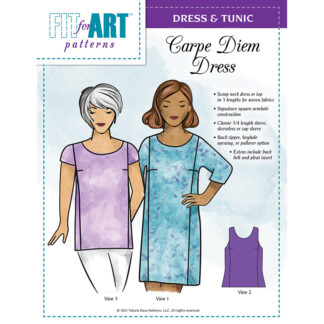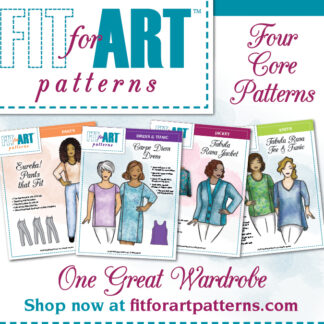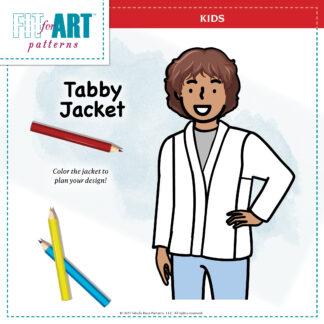
Today we take a closer look at how to make your own binding tape for a quilted jacket or coat. While commercially made binding tape can be purchased, making your own ensures that you can get just the right fabric to match your vision. (For a few projects featuring purchased bias tape by Liberty of London, see Rae’s orange linen duster and knit linen waterfall jackets.)
We hope your New Year’s resolutions include making a quilted jacket! We’ll be writing several blog posts in 2025 featuring the quilted jacket or coat projects in Sewing Quilted Patchwork Jackets with a closer look at some of the techniques used in those projects.
What Kind of Binding Tape?
Binding tape is used in many of the Opus projects. It is used to finish the edges – center front, collar, hem and sleeves – of all the shirt collar style coats and jackets (projects 4, 5, 6, 9 and 10), and in lieu of a wider band for a few of the front band style jackets (projects 3 and 7). Binding tape encloses seam allowances with the classic or reversible seam binding technique for the projects with a quilted-in lining and to finish the edges of patch pockets (project 4). This can add up to a lot of binding tape! Bias tape is also used to add flat piping and for a Hong Kong finish. These binding techniques work for any quilted jacket or coat whether sewing with the Opus, Tabula Rasa, or other jacket pattern.



Take note of whether bias cut strips are required for the application, such as around the curve of a shoulder seam or neckline, or whether strips may be cut on the straight of grain (or cross grain). Guidelines for orientation are included in each project’s instructions in Sewing Quilted Patchwork Jackets, but the choice may also be influenced by the appearance of the fabric. For example, the binding fabric for the Treadle Cat Barn Coat looked very different when cut on the straight of grain or cross grain than when cut on the bias; we preferred the look of bias for all the strips. Test the different ways to cut your binding fabric by laying it against the jacket sections before you start cutting.



Calculate Width and Length for Binding Strips
When preparing to make binding tape, first decide which kind of finish it’s to be used for and how wide the finished tape needs to be. Follow the guidelines in the book to calculate how wide to cut strips for your application. For example, most of the shirt collar style jackets are finished with ½” wide classic binding, which requires 2” wide strips to start. Hong Kong and reversible seam binding require different width strips.
Measure to calculate how many inches of binding tape are required for your application, adding several inches as needed to join strips or wrap corners. The strips do not all need to be joined into one continuous length of binding, as they do when binding a quilt. A single strip may be long enough to bind a shoulder seam, the edge of a collar, the center front of a collared jacket from collar to hem, or the hem of a cuff. Other applications will require joining two or more strips, such as the hem of a coat or jacket, the neckline and center front of a front band style jacket, or a side seam.
Cut and Join Strips for Binding Tape
There’s advice all over the sewing and quilting literature and the web for the “best” way to cut binding strips, so you may want to experiment and find what method(s) you prefer. Carrie and Rae typically use a rotary cutter and ruler with a cutting mat for precision and speed. To cut on the true bias, it’s helpful to use a mat that includes markings for a 45 degree angle to guide you.



When strips need to be joined, we prefer to stitch them together at a 45 degree angle to distribute the bulk of the seam allowances. Trim the seam allowances to ¼”, press open, trim off the little triangles that extend beyond the long edge of the strips, and press again from the right side.
Press Strips into Binding Tape
All that’s needed to turn your strips into useful binding tape is a hot steam iron and pressing surface. Press well to get crisp folds with staying power:
- Press the strip in half lengthwise, wrong sides together.
- Open out the pressed strip and fold one long edge toward the center fold WST; press well.
- Repeat, pressing the other long edge toward center fold.
- Re-fold the binding along the center fold and press one more time.




If you have a silicone pressing tool handy, use it to avoid burning your fingers; Carrie likes these ugly old rubber finger covers.
Because we were going to be making lots of binding for the 10 projects in the book, Fit for Art invested in an electrical gadget recommended by one of our retreat students – a Simplicity Bias Tape Maker. What a game changer! The binding strips are still prepared manually, but then are fed through the machine with its own heated ironing surface to do the pressing quickly and accurately. It came with several different size tips for making different width bindings. Intrigued? Watch Carrie’s video demo with the Simplicity Bias Tape Maker.
We can’t wait to see your quilted jackets and coats, so send us photos or post online with #opusjacket and #quiltedjacket.
Happy Sewing and Quilting, Carrie
P.S. If you are interested in buying a tape maker, search online for the best price as it varies considerably.







I just bought your book and I can’t wait to make another jacket. I have made a number of Tabula Rasa jackets, shirts, reversible… can I use my?
Mockup for my TR pattern? Can you tell us what changes to make for the Opus Jacket… Or is it best to print out that pattern and lay it out on the pattern we have already made?
My book just arrived yesterday and I’m excited about the projects.
I’ve been using your pattern since I took a class from Rae way back when you came to Steve’s Sew and Vac in King of Prussia
So nice to hear from you Lynda! You have been with us for a very long time indeed. The primary differences in the Opus pattern as compared to the TRJ were made to create more of an overcoat fit. The shoulders are wider, the armhole is dropped to create more space, there is a bit more ease through the body, and we lengthened the jacket and added a coat length. You might be able to compare your adjusted TRJ pattern to the Opus tiles printed in the book section by section or you might decide it’s easier to print the opus in your size(s) and make adjustments to it based on your TRJ pattern. We look forward to seeing you quilted jackets!